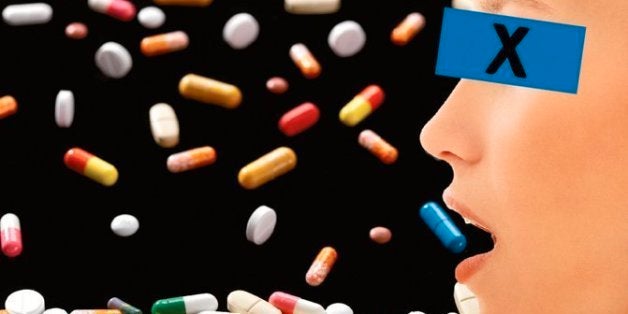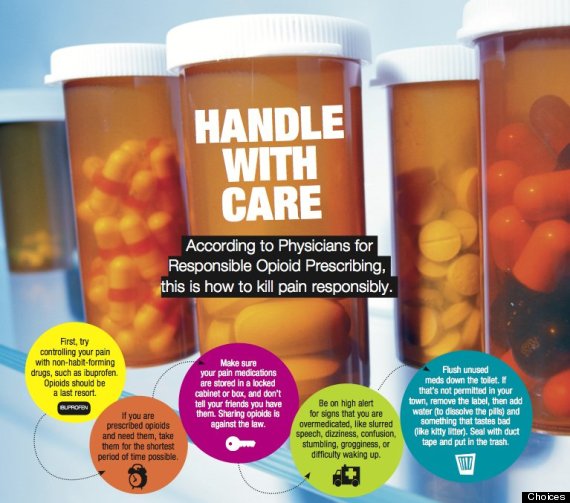
The ugly side of prescription painkillers—and how you could get hooked.
By Elizabeth Foy Larsen
The afternoon of her grandmother’s funeral, Brittany, 19, sat on the bed in what used to be her grandmother’s room, relieved to have finally snuck off after spending all day with her grieving family. In her trembling hands, she held a beaded plastic purse. Brittany knew it belonged to her younger cousin, but still she nervously reached inside, pulling out a $5 bill with her clammy fingers.
Brittany had been furiously rifling through her family’s bags and coat pockets for 30 minutes already, careful to be quiet as her family mourned—somber and teary-eyed—on the other side of the door. She was searching for cash or anything she could steal to sell so she could get high. All the while, her head was aching, and her mouth was dry.
Brittany was desperate. Yet, as desperate as she was, she couldn’t shake the feeling that stealing from a 6-year-old was a new low. How had she gotten here, she wondered—and what had she become?
The answer was at turns frighteningly simple and dizzyingly complex. It all began three years earlier. Brittany had been a bright 16-year-old with good grades and braces, who loved shooting hoops and playing with her dog. After Brittany had her wisdom teeth removed, her orthodontist prescribed Percocet, a commonly used painkiller, for her post-surgery discomfort.
What nobody told Brittany, however, was that using it has a downside. Percocet is a powerful and highly addictive medication—part of a class of drugs called opioids, that are no different chemically than their illegal counterpart, heroin. For one week after her surgery, Brittany took the Percocet every few hours, just as her doctor had prescribed. And with each pill, a numb feeling washed over her—a feeling that she grew to look forward to.
A week later, her pain was gone. But she still had some pills left. So she took one, just for fun.
That single, seemingly innocent, just-for-fun pill led to another, and then another. And before she even realized it, Brittany didn’t just want the drug—she needed it to get out of bed in the morning. Over time, each pill had been changing the chemistry of her brain, turning the happy South Florida honors student into a desperate addict.
THE SILENT EPIDEMIC
Brittany’s story may seem shocking, but she’s far from alone. Today, the Center for Disease Control classifies prescription drug abuse as the worst drug epidemic in United States history. One in four teens have misused or abused prescription medications at least once. And that’s not all: Pills are the most commonly abused drug among 12- and 13-year-olds, according to the Medicine Awareness Project, a campaign of the Partnership for Drug-Free Kids. More Americans die each year from overdosing on prescription medications than die from heroin, methamphetamine, and cocaine combined.
Most of these addicts start like Brittany—accidentally. “I’ve seen plenty of people who’ve never used drugs or alcohol get addicted to painkillers,” says Dr. Andrew Kolodny, the president of Physicians for Responsible Opioid Prescribing. “Someone who takes an opioid prescribed for a sports injury might find out it feels good and want to try it again.”
So why are these drugs being prescribed if they’re so risky? The main reason is lack of knowledge. “There’s very little education about addiction in medical and dental school,” explains Steve Pasierb, president and CEO of the Partnership for Drug-Free Kids. “Doctors and dentists don’t understand a lot about the problem.”
HIJACKED BY PILLS
Brittany’s problem began before she even realized what was happening. As she worked her way through her leftover Percocet, she stopped thinking about her homework and things she used to love, like painting with her mom or riding bikes with her dad. She started hanging out with other kids who used pills (they were surprisingly easy to find). These more experienced users encouraged her to try Roxicodone, or roxys, an opioid more powerful than Percocet. Within a few months, Brittany was grinding up roxys to snort and to smoke—sometimes several times a day.
She told herself that she was just having fun with opioids, and that she could stop whenever she wanted. That was an illusion. “These drugs do the same thing to your brain as heroin,” says Pasierb. “If alcohol and marijuana are like a punch in the head, pain pills are nuclear war.”
Brittany’s brain, like all addicts’, had been hijacked by the pills. And when you’re under 25, it’s even easier for the drugs to take the wheel, since your brain is still developing—and therefore more susceptible to addiction. “When a young person abuses or misuses prescription pills, it messes up the reward system in the brain,” says Pasierb. “The pills become rewards—not love, getting good grades, video games, or sports.”
That means that when the prescription drugs become too difficult to find, many once-straightlaced teens turn to illegal drugs, like heroin. In fact, four out of five heroin users started abusing drugs by taking prescription opioids, according to the Partnership for Drug-Free Kids.
PLAYING WITH FIRE
When you hear about people like Brittany, whose addiction started so innocently, it’s tempting to write off all painkillers and blame the doctors who prescribe them. But the truth is that prescription painkillers aren’t inherently bad. In fact, they are absolutely necessary for many life-saving surgical procedures or serious illnesses. “If someone has cancer, for example, they shouldn’t have to suffer. They deserve to be prescribed a severe drug that will ease their severe pain,” says Pasierb. Unfortunately, though, painkillers are often prescribed when an over-the-counter pain medicine like Motrin or Tylenol would be just as effective.
Another huge part of the problem is that the dangers of prescription drugs don’t get a lot of attention. While 81 percent of teens say that their parents have discussed the risks of marijuana, only 14 percent say their parents have talked to them about misusing legal drugs. When you don’t hear that much about prescription drug abuse, how are you supposed to know that it’s such a big deal? “I wish my doctor would have told my parents about the harm these drugs can do,” says Brittany. “They would have asked for something else or given them to me as needed.”
ROAD TO RECOVERY
As she stared down at that $5 bill the day of her grandmother’s funeral, Brittany recognized just how drastically her morals had been bent by her addiction. So she tucked the bill back into her cousin’s purse and left the room, determined to get clean. Unfortunately, the opioids had changed her brain chemistry so dramatically that deciding whether to continue to use drugs was no longer her choice to make.
Whenever she went too long without roxys or other opioids, Brittany had skull-splitting headaches, an excruciating cough, and other symptoms that felt like the worst flu of her life. Without drugs in her body, she was anxious and paranoid. These are classic signs of opioid withdrawal—miserable symptoms that go away only when you take more drugs.
It was months before Brittany called her mother in the middle of the night, desperate to feel better. Thankfully, her mother helped her check into residential treatment the week after she turned 20. Five years later, she’s so committed to staying clean that she runs a treatment center for women, called Lighthouse Recovery Institute.
Every day, Brittany works with young women who are as addicted to pills as she was. “They think they can stop when they want to,” she says. “Addiction deceives us by letting us think that we can use drugs on our own terms.”
But once you’re addicted, the part of your brain in the driver’s seat is the part that wants and needs pills. “It doesn’t let you think about the lives you are destroying and the dreams you are killing,” Brittany adds. “My family lost trust in me, and I lost my childhood friends too.”
Now that Brittany is drug-free, that’s all changed.
“I get to help spread the message that I never heard about the dangers of prescription drugs—as well as the fact that recovery is possible.”

This article originally appeared in the October issue of Choices. For more information about the magazine, click here.

